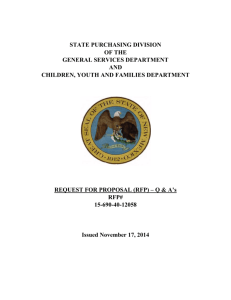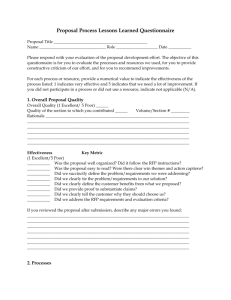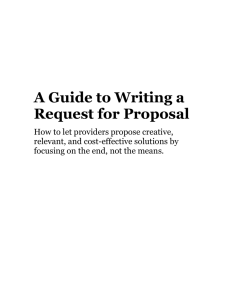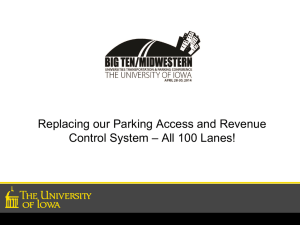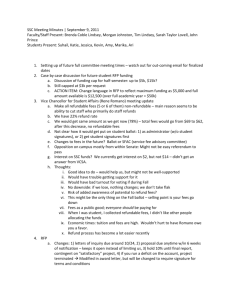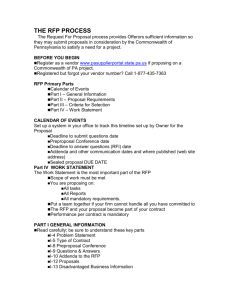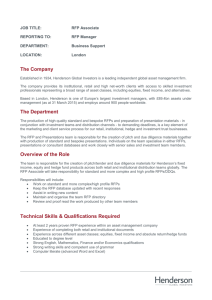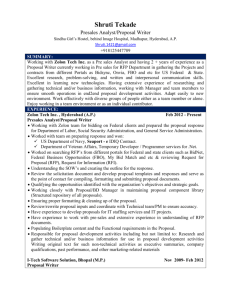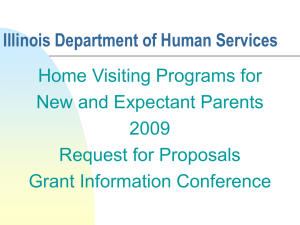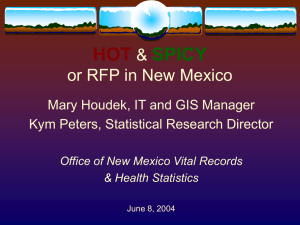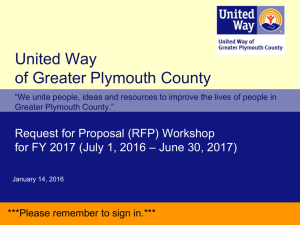External Funding Outlook FY2006: Current and Future Trends in
advertisement
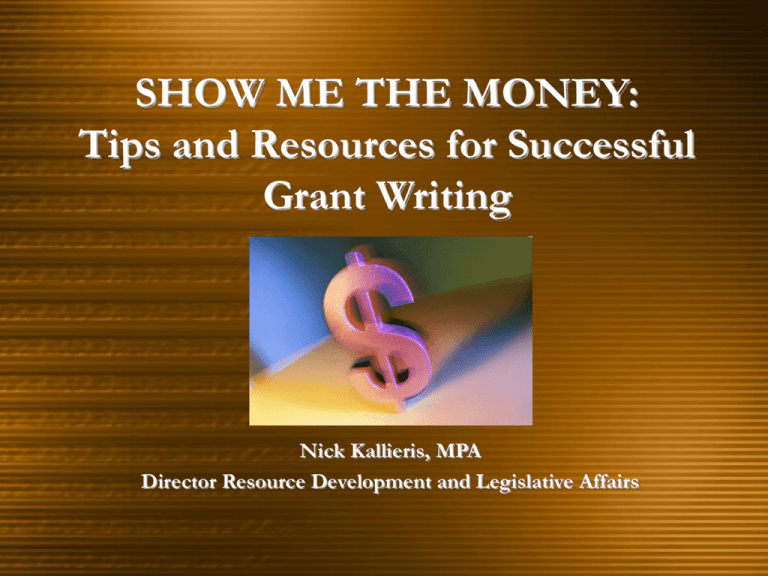
SHOW ME THE MONEY: Tips and Resources for Successful Grant Writing Nick Kallieris, MPA Director Resource Development and Legislative Affairs Resource Development and Legislative Affairs B209 Nick Kallieris, Director Nina Smith, Grant Specialist Marina Kibardina, Grant & Budget Specialist Harriet Seltzer, Senior Secretary Overview of Grant Services Provided • Participate in preliminary grant discussions • Identify external funding sources • Interpret grant guidelines • Write, edit, design, and develop a wide variety of projects with faculty and staff • Complete required forms and mail proposals • Assist in overall grants management • Ensure grant expenditure compliance WE ARE HERE TO HELP! So, what is a grant? Funds from a federal, state, or private source for a SPECIFIC purpose – Must submit a proposal to receive these funds COMPETITIVE!!! OK, so what is a proposal? The proposal is the institution’s offer of contract to perform certain services for which the grantor agency will provide funds. The proposal must… • State clearly what the college proposes to do. • Show how the project will advance the grantor’s own purposes – Follow the RFP exactly!!! • Demonstrate the project’s uniqueness – Why fund this one??? • Convince the grantor that the college and its personnel are capable of carrying out the project successfully. RFP? Many corporate and private foundations and ALL government funding sources provide guidelines (also known as, Requests for Proposal or RFP) that have detailed requirements regarding proposal submission. – Solicited by funders (state, federal, foundation) through mail, listserves, and websites OR – Found through internet searches, direct mail, networking, internal tips (MORE ON THIS LATER) To submit or not to submit, that is the question. •What are the odds of being funded? •Does the project idea fit CLC’s mission? •Do we have the correct agency and grant program for our idea/project? •Do we have the expertise at our college and/or the right partners? •Do we have support from the college for the project (especially matching $$)? •Do we have a champion to direct the project? •Do we have the resources to write the proposal (time and information)? •Are we prepared to win? •Do we have the office space??? LET’S GO FOR IT!!! Proposal Construction A proposal usually contains the following components: • Abstract/Summary: clearly and concisely summarizes the request. • Problem Statement or Needs Assessment: documents the needs to be met or problems to be addressed by the proposed funding. • Goals and Objectives: establishes the benefits of the funding in measurable terms. • Plan of Operation/Methodology: describes the activities to be undertaken. Continued… • Key Personnel: demonstrates to the reader that you are capable of doing what you propose • Evaluation: presents a plan for determining the degree to which objectives are met and methods are followed. • Budget: explains the costs associated with project implementation and separates costs to be provided by the funding source and applicant. Abstract/Summary •Write it last! •Summarizes all the important information from the proposal – Who? What? Where? Why? How? How Much? •Crucial first impression •Use layman’s terms – no jargon – It’s Greek to me (and I should know) •Convey enthusiasm Needs Assessment •Identify need – must be important and significant •The Why? Section of the proposal •Usually used to decide if funded or not •Again, use layman’s terms – no jargon •Be specific (never make a reader guess) or assume something. •Don’t whine, cry or beg •Use statistics, cite examples, relate to funders mission Goals and Objectives Goal: describes the overall expected outcome or result of the project Objectives: establish the benefits of the grant in measurable terms Do what? (reduce, increase, maintain) Using what approach? By when? With what measure? With what result? Example of Measurable Objectives Process Objective One thousand (1000) low-income and first-generation participants will be recruited, identified, selected, and assessed to participate in the Talent Search program by November of each year. Of this number, 350 will be seniors and juniors, 330 will be ninth and tenth graders, and 320 will be junior high school students. Two-thirds (2/3) or 330 will be low income and first generation. Outcome Objective At least 85% of the 1000 participants will be retained in school and in the Talent Search program from year to year. At least 95% of all senior participants will graduate from high school, and at least 60% will enroll in postsecondary education. Plan of Operation/Methodology • Fully describe activities to be undertaken and how • Flows directly from the Need, Goals and Objectives • Describe staffing and sequence of activities (Very detailed) • Use charts, tables, timelines, etc. • Usually worth the most points and the largest section of the grant. Key Personnel/Qualifications • Does the proposed project staff have the qualifications and expertise? Describe! • Other valuable resources at the college? What makes CLC special? Describe • Partnerships? What do they bring to the success of the project? (Business, K-12, University, Faith-Based, Social Services) Evaluation • How will we know that the project is successful? • Explain evaluation criteria and plan • What data will be collected? When? Who will collect it? How? • What will you do with the data? • Accountability/Compliance/Evaluation (Results must be measurable!!! – not interested in anecdotes) Budget • Itemize and account for ALL costs – (Personnel, Fringe, Consultants, Printing, Postage, Equipment, Supplies, Travel/Mileage) • Must come from Plan of Operation – if not listed, do not put in budget • Written justification of all budget items • Be accurate – do not overestimate costs or resources needed SHHHH!!! Super Secret Tips RULE #1 -- FOLLOW THE RFP!!! The RFP lists due date, margins, page numbers, font, page limits, number of copies, budget amount, number to be funded – everything you need to know!! Other tips – • Call the grant staff and talk to them •The proposal should read like one person wrote it •Be clear, concise and direct •Use the active voice and avoid jargon •Use headings, bullets, formatting, white space to make it easy to read •PROOFREAD!! Ask a friend. Check for spelling and typographical errors •Does it make sense? Flow? Is it well thought out from page 1 to page 100? Common Reasons for Rejection •Guidelines were not followed exactly •Idea is not original •Incomplete or unclear descriptions •Not qualified •Poor writing •Carelessness and Inattention to detail •Unrealistic budget •Costs out of proportion with benefits •Submission deadline not met •Not enough $$$$ to go around – Highly Competitive Preparing for Next Time •Don’t give up •We will obtain reviewer’s comments – (Very Important!) •Re-work, Re-submit Sources of Grant Funds Check out the Resource Development and Legislative Affairs website @ http://www.clcillinois.edu/depts/red.asp • • • • • • • • • • • • • www.grants.gov http://foundationcenter.org/pnd/rfp/ American Association of Community Colleges (AACC) Association of Community College Trustees Catalog for Federal Domestic Assistance Council for Resource Development Directory of Postsecondary Education Programs ED Discretionary Grant Application Packages for Currently Open Grant Competitions TA US DOL Employment and Training Administration Federal Register Documents - Announcements, Application Notices, Request for Comments, etc. January 2002 to present Illinois Board of Higher Education Illinois Community College Board Illinois State Library - Grants Page QUESTIONS??
